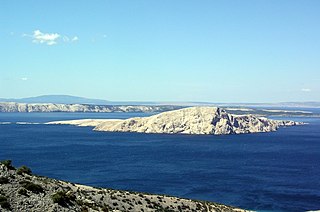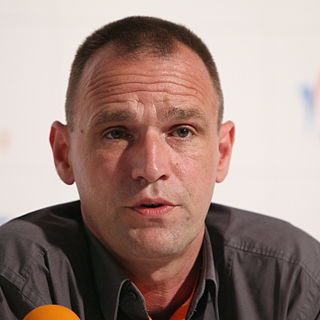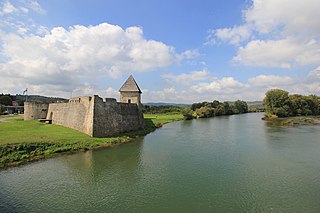This article needs additional citations for verification .(April 2019) |
Millions on the Island (Milioni na otoku) is a 1955 Croatian film directed by Branko Bauer. [1]
This article needs additional citations for verification .(April 2019) |
Millions on the Island (Milioni na otoku) is a 1955 Croatian film directed by Branko Bauer. [1]

Goli Otok is a barren, uninhabited island that was the site of a political prison which was in use when Croatia was part of Yugoslavia. The prison was in operation between 1949 and 1989.

Chakavian or Čakavian is a South Slavic supradialect or language spoken by Croats along the Adriatic coast, in the historical regions of Dalmatia, Istria, Croatian Littoral and parts of coastal and southern Central Croatia, as well as by the Burgenland Croats as Burgenland Croatian in southeastern Austria, northwestern Hungary and southwestern Slovakia as well as few municipalities in southern Slovenia on the border with Croatia.

Vinko Brešan is a Croatian film director best known for directing several notable Croatian black comedies.

The cinema of Croatia has a somewhat shorter tradition than what is common for other Central European countries: the serious beginning of Croatian cinema starts with the rise of the Yugoslavian film industry in the 1940s. Three Croatian feature films were nominated for the Academy Award for Best Foreign Language Film, several of them gained awards at major festivals, and the Croatian contribution in the field of animation is particularly important.

Premuda is a small island in Croatia, off the northern Adriatic coast. It belongs to the north Dalmatian islands which are situated north-west from the county center Zadar. Premuda is approximately 9 km (6 mi) long, up to 1.6 km (1.0 mi) wide, and has an area of 9.2 km2 (3.6 sq mi). It is situated southwest of Silba and northwest of Škarda and as such it is one of the outermost Adriatic islands from the perspective of the Croatian coastline.

Blato is a municipality on the island of Korčula in Croatia. It can be reached by the main island road from town of Korčula. The road runs through the forests in the middle of the island of Korčula.

Veljko Bulajić was a Montenegrin film director and UNESCO Kalinga Prize recipient. Bulajić spent the majority of his life working in Croatia and is primarily known for directing World War II-themed movies from the Partisan film genre. According to the Croatian Public Broadcasting Company, his films have reached an audience of over 500 million viewers worldwide. The top four most viewed Yugoslav films of all time were all directed by Bulajić. MUBI streaming service describes Bulajić as "a creator of made-to-order epic blockbusters".

Biševo is a Croatian island in the Adriatic Sea. It is situated in the middle of the Dalmatian archipelago, five kilometers southwest of the Island of Vis. Its area is 5.8 km2 (2.2 sq mi) and it has a population of 15.

Branko Bauer was a Croatian film director. He is considered to be the leading figure of classical narrative cinema in Croatian and Yugoslav cinema of the 1950s.

St. Michael Fort is fort on the Croatian island of Ugljan.

Kostajnica Fortress is a castle in Hrvatska Kostajnica, a town in central Croatia, near the border to Bosnia and Herzegovina.

How the War Started on My Island is a 1996 Croatian black comedy film directed by Vinko Brešan and starring Vlatko Dulić, Ljubomir Kerekeš, Ivan Brkić, Predrag Vušović, Ivica Vidović, Božidar Orešković and Matija Prskalo.
Živko Zalar is a Croatian cinematographer, son of Croatian cinematographer Slavko Zalar.
Vlatko Dulić was a Croatian theatre, television and film actor and theatre director.

Za križen is a night procession that happens every Maundy Thursday on the island of Hvar, Croatia. The event has centuries of tradition and is included in the UNESCO Intangible Cultural Heritage Lists.

Ivan Čurjurić is a Croatian professional footballer who plays as an attacking midfielder for HNK Zadar.

MF Bartol Kašić is a ferry, built in 1989, operated by Croatian state-owned company Jadrolinija, and navigating on local routes in Croatia. Capacity of the ship is 500 passengers, 54 cars. Maximum speed is 13 knots.
Hermina Pipinić was a Croatian actress. She attended an acting school in Zagreb and debuted on stage in 1948 at the First Drama Theatre in Zagreb.
Vrandečić is a Croatian surname. The name is known only to originate from Pučišća on the island of Brač. The oldest mention of the name is from 1674. The meaning of the name is not entirely clear. The most likely explanation is that it comes from the first name Vrandeka, Vrane, Frane.
Petrica Novosel Žic was a Croatian cartographer and geography professor at the University of Zagreb.